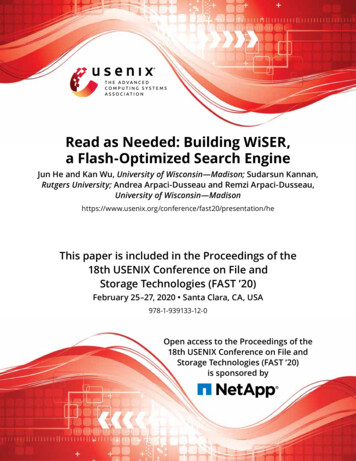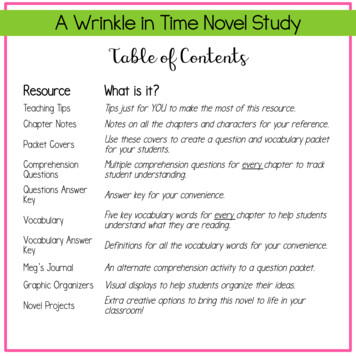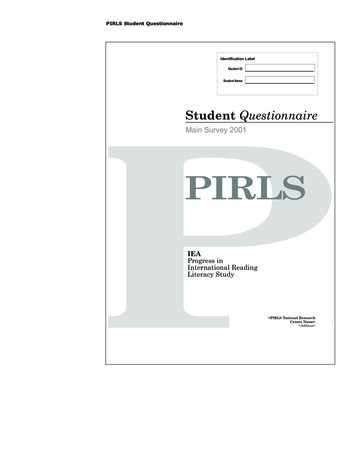
Transcription
Read as Needed: Building WiSER,a Flash-Optimized Search EngineJun He and Kan Wu, University of Wisconsin—Madison; Sudarsun Kannan,Rutgers University; Andrea Arpaci-Dusseau and Remzi Arpaci-Dusseau,University of ce/fast20/presentation/heThis paper is included in the Proceedings of the18th USENIX Conference on File andStorage Technologies (FAST ’20)February 25–27, 2020 Santa Clara, CA, USA978-1-939133-12-0Open access to the Proceedings of the18th USENIX Conference on File andStorage Technologies (FAST ’20)is sponsored by
Read as Needed: Building WiSER, a Flash-Optimized Search EngineJun He, Kan Wu, Sudarsun Kannan† , Andrea C. Arpaci-Dusseau, Remzi H. Arpaci-DusseauDepartment of Computer Sciences, University of Wisconsin–Madison† Department of Computer Science, Rutgers UniversityAbstractWe describe WiSER, a clean-slate search engine designedto exploit high-performance SSDs with the philosophy "readas needed". WiSER utilizes many techniques to deliver highthroughput and low latency with a relatively small amountof main memory; the techniques include an optimized datalayout, a novel two-way cost-aware Bloom filter, adaptiveprefetching, and space-time trade-offs. In a system with memory that is significantly smaller than the working set, thesetechniques increase storage space usage (up to 50%), but reduce read amplification by up to 3x, increase query throughputby up to 2.7x, and reduce latency by 16x when compared tothe state-of-the-art Elasticsearch. We believe that the philosophy of "read as needed" can be applied to more applicationsas the read performance of storage devices keeps improving.1IntroductionModern solid-state storage devices (SSDs) [19, 20] providemuch higher throughput and lower latency than traditionalpersistent storage such as hard disk drives (HDDs). Currently,flash-based SSDs [19, 20] are readily available; in the nearfuture, even higher performance NVRAM-based systems maysupplant flash [4], boosting performance even further.SSDs exhibit vastly different characteristics fromHDDs [24, 36]; as we shift from HDDs to SSDs, the softwareon top of the storage stack must evolve to harvest thehigh performance of the SSDs. Thus far, optimization forSSDs has taken place within many important pieces of thestorage stack. For example, RocksDB [16], Wisckey [38]and other work [23, 34, 42] have made key-value storesmore SSD-friendly; FlashGraph [59], Mosaic [43] andother work [48, 49, 60] optimize graphs for SSDs; SFS [45],F2FS [39] and other work [30, 37] have made systemssoftware more SSD-friendly.In this evolution, an important category of application hasbeen overlooked: full-text search engines. Search enginesare widely used in many industrial and scientific settings today, including popular open-source offerings such as Elasticsearch [7] and Solr [3]. As of the time of this writing, Elasticsearch is ranked 7th among all database engines, higher thanwell-known systems such as Redis, Cassandra, and SQLite [6].Elasticsearch is used in important applications, such as atWikipedia and Github to power text (edited contents or sourceUSENIX Associationcode) search [7, 22]. They are also widely used for data analytics [7]; for example, Uber uses Elasticsearch to generatedynamic prices in real time based on users’ locations.Furthermore, the challenges in search engines are unique,interesting, and different from the ones in key-value stores,graphs, and system software. The key data structure in asearch engine is an inverted index, which maps individualterms (i.e., words) to lists of documents that contain the terms.On top of the inverted index, multiple auxiliary data structures (e.g., posting lists) and technologies (e.g., compression)also play important roles to implement an efficient searchengine. In addition to compelling data structures, the uniqueworkloads of search engines also provoke new thoughts onSSD-based optimizations. For example, phrase queries (e.g.,“United States”) stress multiple data structures in the engineand require careful design.Search engines pose great challenges to storage systems.First, search engines demand low latency as users often interface with them interactively. Second, search engines demandhigh data throughput because they retrieve information from alarge volume of data. Third, search engines demand high scalability because data grows quickly. Due to these challenges,many search engines eschew using secondary storage, puttingmost/all data directly into memory instead [13, 15].However, we believe the advent of faster storage suggestsa reexamination of modern search engine design. Given thatusing RAM for large datasets can be cost prohibitive, canone instead rebuild a search engine to better utilize SSDs toachieve the necessary performance goals with main memorythat is significantly smaller than the dataset?We believe the answer is yes, if we re-design the systemwith the principle read as needed. Emerging fast storage devices [14, 18, 29, 36, 57] offer high bandwidth; for example,inexpensive (i.e., 0.17/GB) SSDs currently offer 3.5 GB/sread bandwidth [17], and even higher performance can beprovided with multiple devices (e.g., RAID). These highperformance storage devices allow applications to read dataas needed, which means that main memory can be used asa staging buffer, instead of a cache; thus, large working setscan be kept within secondary storage and less main memoryis required. To read as needed, applications must optimize theefficiency of the data stream flowing from the storage device,through the small buffer (memory), to CPU.18th USENIX Conference on File and Storage Technologies59
In this paper, we present the design, implementation, andevaluation of WiSER, a flash-optimized high-I/O search engine that reads data as needed. WiSER reorganizes traditional search data structures to create and improve the readstream, thus exploiting the bandwidth that modern SSDs provide. First, we propose a technique called cross-stage grouping, which produces locality-oriented data layout and significantly reduces read amplification for queries. Second, wepropose a novel two-way cost-aware Bloom filter to reduceI/O for phrase queries. Third, we use adaptive prefetch toreduce latency and improve I/O efficiency. Fourth, we enablea space-time trade-off, increasing space utilization on flashfor fewer I/Os; for example, we compress documents individually, which consumes more space than compression ingroups, but allows us to retrieve documents with less I/O.ID123Table 1: An Example of Documents An indexer parses thedocuments to build an inverted index; a document store willkeep the original text.Term Map cheese curdWiSER1We builtfrom ground up with 11,000 lines of C code, for the following reasons. First, an implementation inC allows us to interact with the operating system moreclosely than the state of the art engine, Elasticsearch, whichis written in Java; for example, it allows us to readily prefetchdata using OS hints. Second, a fresh implementation allowsus to reexamine the limitations of current search engines. Forexample, by comparing with WiSER, we found that the network implementation in Elasticsearch significantly limits itsperformance and could be improved. Overall, our clean slateimplementation produces highly efficient code, which allowsus to apply various flash-optimized techniques to achievehigh performance. For some (but not all) workloads, WiSERwith limited memory performs better than Elasticsearch withmemory that holds the entire working set.We believe that this paper makes the following contributions. First, we propose a design philosophy, read as needed,and follow the philosophy to build a flash-optimized search engine with several novel techniques. For example, we find thatplain Bloom filters employed elsewhere [11, 16, 42] surprisingly increase I/O traffic; consequently, we propose two-waycost-aware Bloom filters, which exploit unique properties ofsearch engine data structures. Second, WiSER significantlyreduces the need for vast amounts of memory by exploitinghigh-bandwidth SSDs to achieve high performance at lowcost. Third, we have built a highly efficient search engine:thanks to our proposed techniques and efficient implementation, WiSER delivers higher query throughput (up to 2.7x)and lower latencies (up to 16x) than a state-of-the-art searchengine (Elasticsearch) in a low-memory system that we useto stress the engine.The paper is organized as follows. We introduce the background of search engines in Section 2. We propose techniquesfor building a flash-optimized search engine in Section 3.We evaluate our flash-optimized engine in Section 4, discussrelated work in Section 5, and conclude in Section 6.1 WiSER60is available at 8th USENIX Conference on File and Storage TechnologiesTextI thought about naming the engine CHEESE, but Icould not explain CHEE.Fried cheese curds, cheddar cheese sale.Tofu, also known as bean curd, may not pair wellwith cheese. Postings Lists ID123TF121POS72,512 OFF(34,39)(6,11),(28,33)(52,57)ID TF POS OFF2 1 3(13,17)3 1 6(25,28)A Posting Figure 1: An Example of Inverted Index This figure showsthe general contents of inverted index without specific layoutinformation. Term Map allows one to look up the location ofthe postings list of a term.2Search Engine BackgroundSearch engines play a crucial role in retrieving informationfrom large data collections. Although search engines are designed for text search, they are increasingly being used fordata analytics because search engines do not need fixed dataschemes and allow flexible data exploration. Popular modernsearch engines, which share similar features, include Elasticsearch, Solr, and Splunk [6]. Elasticsearch and Solr areopen-source projects based on Lucene [1], an informationretrieval library. Elasticsearch and Solr wrap Lucene by implementing practical features such as sharding, replication,and network capability. We use Elasticsearch as our baselineas it is the most popular [6] and well-maintained project. Although we only study Elasticsearch, our results also apply toother engines, which share the same underlying library (i.e.,Lucene) or key data structures.2.1Elasticsearch Data StructuresSearch engines allow users to quickly find documents (e.g.,text files, web pages) that contain desired information. Documents must be indexed to allow fast searches; the core indexstructure in popular engines is the inverted index, which storesa mapping from a term (e.g., a word) to all the documentsthat contain the term.An indexer builds the inverted index. Table 1 shows anexample of documents to be indexed. First, the indexer splitsa document into tokens by separators such as space and punctuation marks. Second, the indexer transforms the tokens. Acommon transformation is stemming, which unifies tokens(e.g., curds) to their roots (e.g., curd). The transformed tokensare usually referred to as terms. Finally, the location informa-USENIX Association
Read Traffic (GB)1Term Index236POSTerm Dictionary45SkiplistID-TF7OFF100tion of the term is inserted to a list, called a postings list. Theresulting inverted index is shown in Figure 1.A posting contains the location information of a term ina particular document (Figure 1). Such information often includes a document ID, positions, and byte offsets of the termin the document. For example, a position records that term“cheese” is the 2-th and 5-th token in document 2. Positions enable the processing of phrase queries: given a phrase such as“cheese curd”, we know that a document contains the phrase ifthe first term, “cheese”, is the x-th token and the second term“curd” is the x 1-th one. An offset pair records the start andend byte address of a term in the original document. Offsetsenable quick highlighting; the engine presents the most relevant parts (with the queried terms highlighted) of a documentto the user. A posting also contains information such as termfrequency for ranking the corresponding document.Query processing includes multiple stages: documentmatching, ranking, phrase matching, highlighting; differenttypes of queries go through different stages. For queries witha single term, an engine executes the following stages: iterating document IDs in a term’s postings list (documentmatching); calculating the relevance score of each document,which usually uses term frequencies, and finding the top documents (ranking); and highlighting queried terms in the topdocuments (highlighting). For AND queries such as “cheeseAND curd”, which look for documents containing multipleterms, document matching includes intersecting the documentIDs in multiple postings lists. For the example in Figure 1,intersecting {1, 2, 3} and {2, 3} produces {2, 3}, which arethe IDs of documents that contain both “cheese” and “curd”.For phrase queries, a search engine needs to use positions toperform phrase matching after document matching.Figure 2 shows the data structures of Elasticsearch. Toserve a query with a single term, Elasticsearch follows thesesteps. First, Elasticsearch locates a postings list by Term In-USENIX Associationes es no pref wiser 10 1Figure 2: Inverted Index in Elasticsearch Term Index mapsa term to an entry in Term Dictionary. A Term Dictionaryentry contains metadata about a term (e.g., doc frequency)and multiple pointers pointing to files that contain documentIDs and Term Frequencies (ID-TF), positions (POS), and byteoffsets (OFF). The number in the figure indicates a typicaldata access sequence to serve a query. No.3, 4, and 5 indicatethe access of skip lists, document ID and Term Frequencies.For Wikipedia, the sizes of each component are Term Index: 4MB, Term Dictionary: 200 MB, Skiplist.ID.TF: 2.7 GB, POS:4.8 GB, OFF: 2.8 GB. ideally needed in mem16842memory size(GB)10.5Figure 3: Read Traffic of Search Engines This figure showsread I/O traffic of various search engines as the size of memory decreases. es: Elasticsearch, es no pref: Elasticsearchwithout prefetch. Note that serving queries leads to only readtraffic. The ideally-needed traffic assumes a byte-addressablestorage device.dex (1) and a Term Dictionary (2). The Term Index and TermDictionary contain location information of the skip lists, document IDs, positions, and offsets (details below). Second, theengine will load the skip list, which contains more information for navigating document IDs, term frequencies, positions,and offsets. Third, it will iterate through the document IDs anduse the corresponding term frequencies to rank documents.Fourth, after finding the documents with top scores, it willread offsets and document text to generate snippets.2.2Elasticsearch Performance ProblemsElasticsearch cannot achieve the highest possible performancefrom the storage system due in part to read amplification.Elasticsearch groups data of different stages into multiplelocations and arranges data such that data items in the earlystages are smaller. The intention is that data in early stages,which is accessed more frequently than data in later stages, iscached. However, grouping data by stage also could lead tolarge read amplification.Figure 3 shows the I/O traffic of a real query workloadover Wikipedia; as the amount of memory is decreased, theI/O traffic incurred by Elasticsearch increases significantly.In contrast, the amount of read traffic in WiSER remainsrelatively low regardless of the amount of memory available.3WiSER: A Flash-Optimized Search EngineGiven that SSDs offer high bandwidth, applications that "readdata as needed" may be able to run effectively on systems thatdo not contain enough main memory to cache the entire working set. However, since device bandwidth is not unlimited,applications must carefully control how data is organized andaccessed to match the performance characteristics of modernSSD storage [36].At the highest level, the less I/O an application must perform, the faster that application will complete; since searchengine queries involve only read operations, we should reduceread amplification as much as possible. Second, retrievingdata from SSDs instead of RAM can incur relatively longlatency; therefore, applications should hide I/O latency as18th USENIX Conference on File and Storage Technologies61
Term Maptermzone sizelocationtermzone sizelocationtermzone sizelocation md skiplistIDsTFsBFsPOSsOFFs Prefetch ZoneFigure 4: Structure of WiSER’s Inverted Index Contentsof each postings list are placed together. Within each postingslist, IDs, TFs and so on are also placed together to maximizecompression ratio, which is the same as Elasticsearch.much as possible with prefetching or by overlapping computation with I/O. Third, SSDs deliver higher data bandwidthfor larger requests; therefore, an application should organizeand structure its data to enable large requests.We introduce techniques that allow WiSER to reduce readamplification, hide I/O latency, and issue large requests. First,cross-stage data grouping groups data of different stages andstores it compactly during indexing (reducing read implicationand enabling large requests). Second, two-way cost-aware filtering employs special Bloom filters to prune paths early andreduce I/O for positions in the inverted index; our Bloomfilters are novel in that they are tightly integrated with thequery processing pipeline and exploit unique properties ofsearch engines (again reducing read amplification). Third, weadaptively prefetch data to reduce query latency; unlike theprefetch employed by Elasticsearch (i.e., OS readahead), ourprefetch dynamically adjusts the prefetch size to avoid reading unnecessary data (hiding I/O latency and enabling largerequests without increasing read amplification). Fourth, wetake advantage of the inexpensive and ample space of SSDsby trading disk space for I/O speed; for example, WiSERcompresses documents independently and aligns compresseddocuments to file system blocks to prevent data from crossing multiple blocks (reducing read amplification). We nowdescribe these techniques in more detail.In discussing our design, we will draw on examples fromthe English Wikipedia, which is a representative text dataset [33, 35, 44, 50, 53, 54, 56]. Its word frequency follows thesame distribution (zipf’s law) as many other corpuses [41,50],such as Twitter [47].3.1Technique 1: Cross-Stage Data GroupingOne key to building a flash-optimized high-I/O search engineis to reduce read amplification. We propose cross-stage grouping to reduce read amplification for posting lists of small ormedium sizes. The processing of such postings lists is criticalbecause most of the postings lists fall into this category. Forexample, 99% of the postings lists in Wikipedia are small ormedium (less than 10,000 documents are in the postings list).Also, search engines often shard large postings lists into suchsmaller ones to reduce processing latency.Cross-stage data grouping puts data needed for differentstages of a query into continuous and compact blocks on the6218th USENIX Conference on File and Storage Technologiesstorage device, which increases block utilization when transferring data for a query. Figure 4 shows the resulting datastructures after group; data needed for a query is located inone place and in the order that it will be accessed. Essentially,the grouped data becomes a stream of data, in which eachpiece of data is expected to be used at most once. Such expectation matches the query processing in a search engine, inwhich multiple iterators iterate over lists of data. Such streamscan flow through a small buffer efficiently with high blockutilization and low read amplification.Grouped data introduces significantly less read amplification than Elasticsearch for small and medium postings lists.Due to highly efficient compression, the space consumedby each postings list is often small; however, due to Elasticsearch’s layout, the data required to serve a query is spreadacross multiple distant locations (Term Dictionary, ID-TF,POS, and OFF) as shown in Figure 2. Elasticsearch’s layoutincreases the I/O traffic and also the number of I/O operations.On the other hand, as shown in Figure 4, the grouped datacan often be stored in the one block (e.g., 99% of the terms inWikipedia can be stored in a block), incurring only one I/O.3.2Technique 2: Two-way Cost-aware FiltersPhrase queries are pervasive and are often used to improvesearch precision [31]. Unfortunately, phrase queries put greatpressure on a search engine’s storage system, as they requireretrieving a large amount of positions data (as described inSection 2). To build a flash-optimized search engine, we mustreduce the I/O traffic of phrase queries.Bloom filters, which can test if an element is a member ofa set, are often used to reduce I/O; however, we have foundthat plain Bloom filters, which are often directly used in datastores [11, 42, 46], increase I/O traffic for phrase queries because individual positions data is relatively small due to compression and, therefore, the corresponding Bloom filter canbe larger than the positions data.As a result, we propose special two-way cost-aware Bloomfilters by exploiting unique properties of search engines toreduce I/O. The design is based on the observation that thepostings list sizes of two (or more) terms in a phrase query areoften different. Therefore, we construct Bloom filters duringindexing to allow us to pick the smaller Bloom filter to filterout a larger amount of positions data during querying. Inaddition, we design a special bitmap-based structure to storeBloom filters to further reduce I/O. This section gives moredetails on our Bloom filters.3.2.1Problems of plain Bloom filtersA plain Bloom filter set contains terms that are after a particular term; for example, the set.after of term “cheese” indocument 2 of Table 1 contains “curd” and “sale”. To test theexistence of a phrase “cheese curd”, an engine can simplytest if “curd” is in set.after of “cheese”, without reading anypositions. If the test result is negative, we stop and consequently avoid reading the corresponding positions. If the testUSENIX Association
term11BFPOS 2BF POS 2term2Figure 5: Phrase Processing With Bloom Filters WiSERuses one of the Bloom filters to test the existence of a phrase(1) and then read positions for positive tests to confirm (2).result is positive, we must confirm the existence of the phraseby checking positions because false positives are possible inBloom filters; also, we may have to use positions to locatethe phrase within a document for highlighting.However, we must satisfy the following two conditions toreduce I/O. First, the percentage of negative tests must behigh because this is the case where we only read the Bloomfilters and avoid other I/O. If the test is positive (a phrasemay exist), we have to read both Bloom filters and positions,which increases I/O. Empirically, the percentage of positiveresults is low for real phrase queries to Wikipedia [21]: only12% of the tests are positive. Intuitively, the probability fortwo random terms to form a phrase in a document is also lowdue to a large number of terms in a regular document. Thesecond condition is that the I/O traffic to the Bloom filtersmust be smaller than the traffic to positions needed to identifya phrase; otherwise, we would just use the positions.Meeting the second condition is challenging because thesizes of plain Bloom filters are too large in our case, althoughthey are considered space-efficient in other uses [11, 42].Bloom filters can be larger than their corresponding positions because positions are already space efficient after compression (delta encoding and bit packing [2]). In addition,Bloom filters are configured to be relatively large becausetheir false positive ratios must be low. The first reason toreduce false positive is to increase negative test results, asmentioned above. The second reason is to avoid reading unnecessary file system blocks. Note that a 4-KB file systemblock contains positions of hundreds of postings. If any of thepositions are requested due to false positive tests, the whole4-KB block must be read; however, none of the data in theblock is useful.3.2.2 Two-way and cost-aware filteringWe now show how we can reduce I/O traffic to both Bloom filters and positions with cost-aware pruning and a bitmap-basedstore. To realize it, first we estimate I/O cost and use Bloomfilters conditionally (i.e., cost-aware): we only use Bloomfilters when the I/O cost of reading Bloom filters is muchsmaller than the cost of reading positions if Bloom filters arenot used. For example, in Figure 5, we will not use Bloomfilters for query “term1 term2” as the I/O cost of reading theBloom filters is too large. We estimate the relative I/O costsof Bloom filter and positions among different terms by termfrequencies (available before positions are needed), which isproportional to the sizes of Bloom filters and positions.Second, we build two Bloom filters for each term to al-USENIX AssociationSkip List Bitmap Filter Array Bitmap Filter Array Bitmap Filter Array Figure 6: Bloom Filter Store The sizes of the arrays mayvary because some Bloom filters contain no entries and thusare not stored in the array.low filtering in either direction (i.e., two-way): a set for allfollowing terms and another set for all preceding terms ofeach term. This design is based on the observation that thepositions (and other parts) sizes of the terms in a query areoften vastly different. With these two Bloom filters, we canapply filters forward or backward, whichever can reduce I/O.For example, in Figure 5, instead of using Bloom filters ofterm1 to test if term2 is after term1, we can now use Bloomfilters of term2 to test if term1 is before term2. Because theBloom filters of term2 are much smaller, we can apply it tosignificantly reduce I/O.To further reduce the size of Bloom filters, we employ abitmap-based data layout to store Bloom filters. Figure 6shows the data layout. Bloom filters are separated into groups,each of which contains a fixed number of filters (e.g., 128);the groups are indexed by a skip list to allow skipping readinglarge chunks of filters. In each group, we use a bitmap tomark the empty filters and only store non-empty filters in thearray; thus, empty Bloom filters only take one bit of space(in the bitmap). Reducing the space usage of empty filterscan significantly reduce overall space usage of Bloom filtersbecause empty filters are common. For instance, about onethird of the filters for Wikipedia are empty. Empty filters ofa term come from surrounding punctuation marks and stopwords (e.g., “a”, “is”, “the”), which are not added to filters.Empirically, we find that expecting five insertions and afalse positive probability of 0.0009 in the Bloom filter [12](each filter is 9-byte) offers a balanced trade-off betweenspace and test accuracy for English Wikipedia; these parameters should be tuned for other data sets. We use the sameparameters for all Bloom filters in WiSER because storingparameters would require extra space and steps before testingeach filter; one could improve the space overhead and accuracy by limiting the number of parameter sets for the engineand selecting the optimal ones for specific filters from theavailable sets.3.3Technique 3: Adaptive PrefetchingAlthough the latency of SSDs is low, it is still much higherthan that of memory. The relatively high latency of SSDsadds to query processing time, especially the processing oflong postings lists which demands a large amount of I/O. Ifwe load one page at a time as needed, query processing willfrequently stop and wait for data, which also increases systemoverhead. In addition, the I/O efficiency will be low due tosmall request sizes [36].18th USENIX Conference on File and Storage Technologies63
To mitigate the impact of high I/O latency and improve theI/O efficiency, we propose adaptive prefetching. Prefetching, acommonly used technique, can reduce I/O stall time, increasethe size of I/O requests, and reduce the number of requests,which boosts the efficiency of flash devices and reduces system overhead. However, naive prefetching, such as the Linuxreadahead [10], used by Elasticsearch, suffers from significant read amplification. Linux unconditionally prefetchesdata of a fixed size (default: 128 KB), which causes high readamplification due to the diverse data sizes needed.For the best performance, prefetching should adapt to thequeries and the structures of persistent data. Among all datain the inverted index, the most commonly accessed data includes metadata, skip lists, document IDs, and term frequencies, which are often accessed together and sequentially; thuswe place them together in an area called the prefetch zone. Ouradaptive approach prefetches data when doing so can bringsignificant benefits. We prefetch when all prefetch zones involved in a query are larger than a threshold (e.g., 128 KB);we divide the prefetch zone into small prefetch segments toavoid accessing too much data at a time.To enable adaptive prefetch, WiSER employs prefetchfriendly data structures, as shown in Figure 4. A search engineshould know the size of the prefetch zone before reading theposting list (so the prefetch size can be adapted). To enablesuch prefetching, we hide the size of the prefetch zone in thehighest 16 bits of the offset in WiSER’s Term Map (the 48 bitsleft is more than enough to address large files). In addition, thestructure in the prefetch zone is also prefetch-friendly. Datain the prefetch zone is placed in the order it is used, whichavoid jumping ahead and waiting for data that has not beenprefetched. Finally, compressed data is naturally prefetchfriendly. Even if there are data “holes” in the prefetch zonethat are unnecessary for some queries, prefetching data withsuch holes is still beneficial because
many search engines eschew using secondary storage, putting most/all data directly into memory instead [13,15]. However, we believe the advent of faster storage suggests a reexamination of modern search engine design. Given that using RAM for large datasets can be cost prohibitive, can one instead rebuild a search engine to better utilize SSDs to










